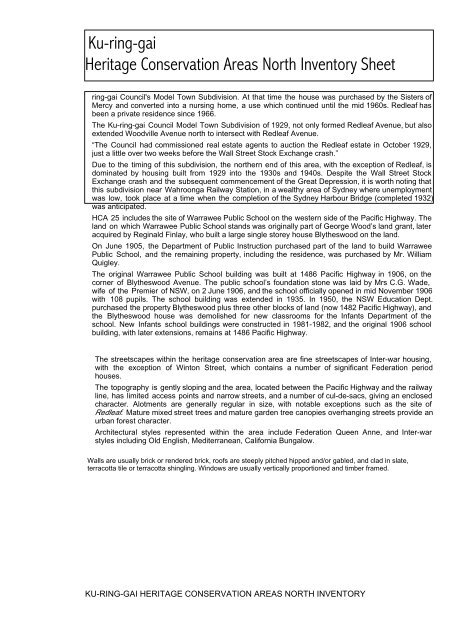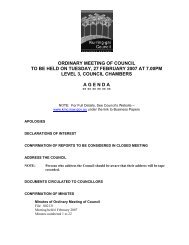Ku-ring-gai Heritage Conservation Areas North Inventory Sheet
Ku-ring-gai Heritage Conservation Areas North Inventory Sheet
Ku-ring-gai Heritage Conservation Areas North Inventory Sheet
You also want an ePaper? Increase the reach of your titles
YUMPU automatically turns print PDFs into web optimized ePapers that Google loves.
<strong>Ku</strong>-<strong>ring</strong>-<strong>gai</strong><br />
<strong>Heritage</strong> <strong>Conservation</strong> <strong>Areas</strong> <strong>North</strong> <strong>Inventory</strong> <strong>Sheet</strong><br />
<strong>ring</strong>-<strong>gai</strong> Council's Model Town Subdivision. At that time the house was purchased by the Sisters of<br />
Mercy and converted into a nursing home, a use which continued until the mid 1960s. Redleaf has<br />
been a private residence since 1966.<br />
The <strong>Ku</strong>-<strong>ring</strong>-<strong>gai</strong> Council Model Town Subdivision of 1929, not only formed Redleaf Avenue, but also<br />
extended Woodville Avenue north to intersect with Redleaf Avenue.<br />
“The Council had commissioned real estate agents to auction the Redleaf estate in October 1929,<br />
just a little over two weeks before the Wall Street Stock Exchange crash.”<br />
Due to the timing of this subdivision, the northern end of this area, with the exception of Redleaf, is<br />
dominated by housing built from 1929 into the 1930s and 1940s. Despite the Wall Street Stock<br />
Exchange crash and the subsequent commencement of the Great Depression, it is worth noting that<br />
this subdivision near Wahroonga Railway Station, in a wealthy area of Sydney where unemployment<br />
was low, took place at a time when the completion of the Sydney Harbour Bridge (completed 1932)<br />
was anticipated.<br />
HCA 25 includes the site of Warrawee Public School on the western side of the Pacific Highway. The<br />
land on which Warrawee Public School stands was originally part of George Wood’s land grant, later<br />
acquired by Reginald Finlay, who built a large single storey house Blytheswood on the land.<br />
On June 1905, the Department of Public Instruction purchased part of the land to build Warrawee<br />
Public School, and the remaining property, including the residence, was purchased by Mr. William<br />
Quigley.<br />
The original Warrawee Public School building was built at 1486 Pacific Highway in 1906, on the<br />
corner of Blytheswood Avenue. The public school’s foundation stone was laid by Mrs C.G. Wade,<br />
wife of the Premier of NSW, on 2 June 1906, and the school officially opened in mid November 1906<br />
with 108 pupils. The school building was extended in 1935. In 1950, the NSW Education Dept.<br />
purchased the property Blytheswood plus three other blocks of land (now 1482 Pacific Highway), and<br />
the Blytheswood house was demolished for new classrooms for the Infants Department of the<br />
school. New Infants school buildings were constructed in 1981-1982, and the original 1906 school<br />
building, with later extensions, remains at 1486 Pacific Highway.<br />
The streetscapes within the heritage conservation area are fine streetscapes of Inter-war housing,<br />
with the exception of Winton Street, which contains a number of significant Federation period<br />
houses.<br />
The topography is gently sloping and the area, located between the Pacific Highway and the railway<br />
line, has limited access points and narrow streets, and a number of cul-de-sacs, giving an enclosed<br />
character. Alotments are generally regular in size, with notable exceptions such as the site of<br />
Redleaf. Mature mixed street trees and mature garden tree canopies overhanging streets provide an<br />
urban forest character.<br />
Architectural styles represented within the area include Federation Queen Anne, and Inter-war<br />
styles including Old English, Mediterranean, California Bungalow.<br />
Walls are usually brick or rendered brick, roofs are steeply pitched hipped and/or gabled, and clad in slate,<br />
terracotta tile or terracotta shingling. Windows are usually vertically proportioned and timber framed.<br />
KU-RING-GAI HERITAGE CONSERVATION AREAS NORTH INVENTORY

















